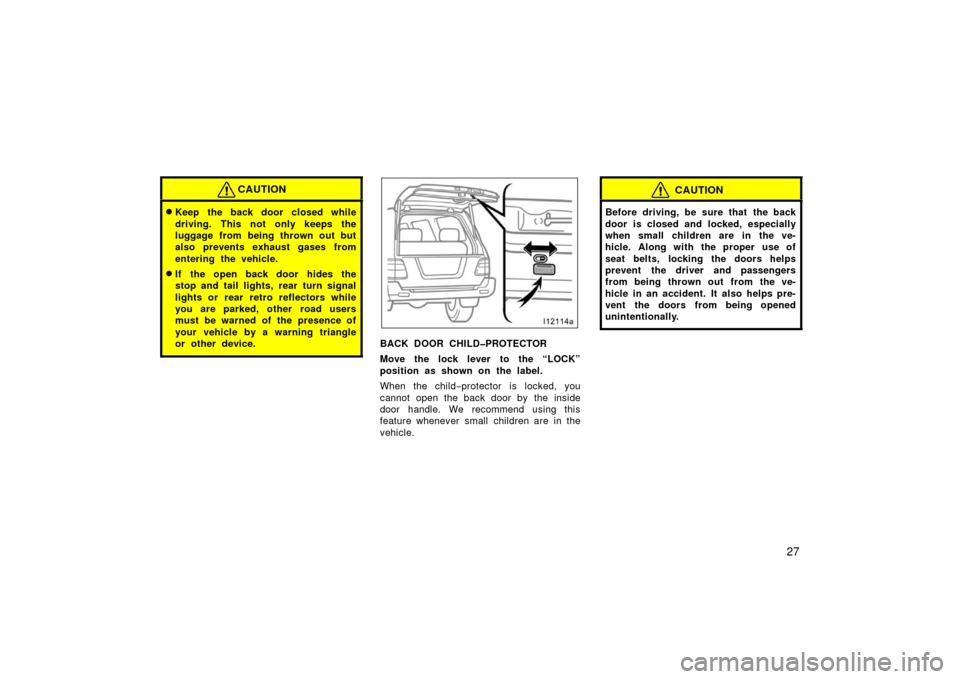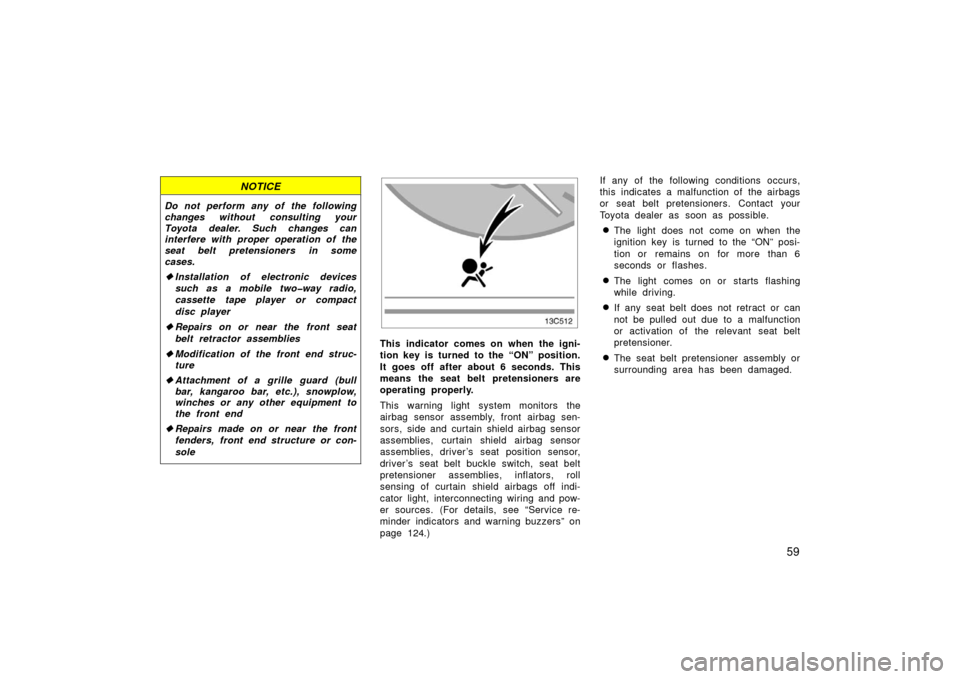Page 13 of 364
3
1. Headlight, turn signal and front foglight switches
2. Cruise control switch
3. Ignition switch
4. Wiper and washer switches
5. Emergency flasher switch
6. Navigation system including air condi- tioning controls (See the separate
“Navigation System Owner ’s Manual”.)
7. Clock and outside temperature display
8. Front passenger ’s seat belt reminder light
9. Audio system
10. Outside rear view mirror heater switch 11. Rear air conditioning switch
12. Rear window defogger switch
13. Center differential lock switch
14. Power antenna switch
15. Power tilt and telescopic steering switch
16. Instrument panel light control dial
17. Power rear view mirror control switches
18. Tire pressure warning system reset switch
19. Power quarter window switch (left− hand side)
20. Power quarter window switch (right −hand side)
21. Roll sensing of curtain shield airbags off switch
�
View B
(Vehicles with navigation system)
11C515b
Page 14 of 364
4
1. Headlight, turn signal and front foglight switches
2. Cruise control switch
3. Ignition switch
4. Wiper and washer switches
5. Emergency flasher switch
6. Clock, outside temperature and trip in- formation display
7. Audio system
8. Front passenger ’s seat belt reminder light
9. Air conditioning controls
10. Outside rear view mirror heater switch 11. Rear air conditioning switch
12. Rear window defogger switch
13. Center differential lock switch
14. Power antenna switch
15. Power tilt and telescopic steering switch
16. Instrument panel light control dial
17. Power rear view mirror control switches
18. Tire pressure warning system reset switch
19. Power quarter window switch (left− hand side)
20. Power quarter window switch (right −hand side)
21. Roll sensing of curtain shield airbags off switch
�
View B
(Vehicles without navigation system)
11C029d
Page 17 of 364
7
Indicator symbols on the instrument panel
Brake system warning light∗1
Malfunction indicator lamp∗1Headlight high beam indicator light Turn signal indicator lights
Driver ’s seat belt reminder light∗1
Anti −lock brake system warning light∗
1
Open door warning light∗1
SRS warning light∗1
Low fuel level warning light∗1
Automatic transmission fluid temperature warning
light∗1
Unengaged “Park” warning light∗1
Charging system warning light∗1
Engine oil replacement reminder light
Center differential lock indicator light Driving pattern (“POWER” mode) indicator
light
Automatic transmission second start indicator
light
Cruise control indicator light∗2
Low tire pressure warning light∗1
Page 18 of 364
8
∗1: For details, see “Service reminder indicators and warning
buzzers” on page 124.
∗2: If this light flashes, see “Cruise control” on page 155.
∗3: For details, see “Roll sensing of curtain shield airbags off
switch” on page 68.
Vehicle stability control system off indicator
light∗1
Vehicle stability control system and active
traction control system warning light∗1
Active traction control system indicator light
Slip indicator light
Roll sensing of curtain shield airbags off indicator light∗ 3
Automatic transmission indicator lights
Page 37 of 364

27
CAUTION
�Keep the back door closed while
driving. This not only keeps the
luggage from being thrown out but
also prevents exhaust gases from
entering the vehicle.
�If the open back door hides the
stop and tail lights, rear turn signal
lights or rear retro reflectors while
you are parked, other road users
must be warned of the presence of
your vehicle by a warning triangle
or other device.
BACK DOOR CHILD�PROTECTOR
Move the lock lever to the “LOCK”
position as shown on the label.
When the child−protector is locked, you
cannot open the back door by the inside
door handle. We recommend using this
feature whenever small children are in the
vehicle.
CAUTION
Before driving, be sure that the back
door is closed and locked, especially
when small children are in the ve-
hicle. Along with the proper use of
seat belts, locking the doors helps
prevent the driver and passengers
from being thrown out from the ve-
hicle in an accident. It also helps pre-
vent the doors from being opened
unintentionally.
Page 68 of 364

58
The seat belt pretensioner system con-
sists mainly of the following components,
and their locations are shown in the il-
lustration.1. Front airbag sensors
2. SRS warning light
3. Seat belt pretensioner assemblies
4. Airbag sensor assembly
The seat belt pretensioners are controlled
by the airbag sensor assembly. The airbag
sensor assembly consists of a safing sen-
sor and airbag sensor. When the seat belt pretensioners are acti-
vated, an operating noise may be heard
and a small amount of non
−toxic gas may
be released. This does not indicate that
a fire is occurring. This gas is normally
harmless.
Once the seat belt pretensioners have
been activated, the seat belt retractors
remain locked.
CAUTION
�Do not modify, remove, strike or
open the seat belt pretensioner as-
semblies, airbag sensor or sur-
rounding area or wiring. Failure to
follow these instructions may pre-
vent the seat belt pretensioners
from activating correctly, cause sud-
den operation of the system or dis-
able the system, which could result
in death or serious injury.
�Do not use tires or wheels other
than the manufacturer ’s recom-
mended size. Such a use may cause
the curtain shield airbags and seat
belt pretensioners to inflate acci-
dentally, resulting in death or seri-
ous injury. For details, see “Check-
ing and replacing tires” on page
323.
�Do not place luggage heavier than
specified on the roof luggage carri-
er. Such luggage may cause the
curtain shield airbags and seat belt
pretensioners to inflate accidentally,
resulting in death or serious injury.
For details, see “Roof luggage car-
rier” on page 218.
�Do not modify or change the sus-
pension system. Such changes may
cause the curtain shield airbags to
inflate accidentally, resulting in
death or serious injury.
Failure to follow these instructions
can result in death or serious inju-
ries. Consult your Toyota dealer
about any repair and modification.
Page 69 of 364

59
NOTICE
Do not perform any of the following
changes without consulting your
Toyota dealer. Such changes can
interfere with proper operation of the
seat belt pretensioners in some
cases.
�Installation of electronic devices
such as a mobile two�way radio,
cassette tape player or compact
disc player
� Repairs on or near the front seat
belt retractor assemblies
� Modification of the front end struc-
ture
� Attachment of a grille guard (bull
bar, kangaroo bar, etc.), snowplow,
winches or any other equipment to
the front end
� Repairs made on or near the front
fenders, front end structure or con-
sole
This indicator comes on when the igni-
tion key is turned to the “ON” position.
It goes off after about 6 seconds. This
means the seat belt pretensioners are
operating properly.
This warning light system monitors the
airbag sensor assembly, front airbag sen-
sors, side and curtain shield airbag sensor
assemblies, curtain shield airbag sensor
assemblies, driver ’s seat position sensor,
driver ’s seat belt buckle switch, seat belt
pretensioner assemblies, inflators, roll
sensing of curtain shield airbags off indi-
cator light, interconnecting wiring and pow-
er sources. (For details, see “Service re-
minder indicators and warning buzzers” on
page 124.) If any of the following conditions occurs,
this indicates a malfunction of the airbags
or seat belt pretensioners. Contact your
Toyota dealer as soon as possible.
�The light does not come on when the
ignition key is turned to the “ON” posi-
tion or remains on for more than 6
seconds or flashes.
�The light comes on or starts flashing
while driving.
�If any seat belt does not retract or can
not be pulled out due to a malfunction
or activation of the relevant seat belt
pretensioner.
�The seat belt pretensioner assembly or
surrounding area has been damaged.
Page 72 of 364

62
Hitting a curb,
edge of pavement
or hard surfaceFalling into or
jumping over a
deep hole
Landing hard or vehicle falling
The SRS front airbags may also deploy
if a severe impact occurs to the under-
side of your vehicle. Some examples
are shown in the illustration.The SRS front airbag system consists
mainly of the following components, and
their locations are shown in the illustra-
tion. 1. Front airbag sensors
2. SRS warning light
3. Airbag module for front passenger (airbag and inflator)
4. Airbag sensor assembly
5. Airbag module for driver (airbag and inflator)
6. Driver ’s seat position sensor
7. Driver ’s seat belt buckle switch
The airbag sensor assembly consists of a
safing sensor and airbag sensor. The front airbag sensors constantly moni-
tor the forward deceleration of the vehicle.
If an impact results in a forward decelera-
tion beyond the designed threshold level,
the system triggers the airbag inflators. At
this time a chemical reaction in the inflat-
ors very quickly fills the airbags with non
−
toxic gas to help restrain the forward mo-
tion of the occupants. The front airbags
then quickly deflate, so that there is no
obstruction of the driver ’s vision should it
be necessary to continue driving.
When the airbags inflate, they produce a
loud noise and release some smoke and
residue along with non −toxic gas. This
does not indicate a fire. This smoke may
remain inside the vehicle for some time,
and may cause some minor irritation to
the eyes, skin or breathing. Be sure to
wash off any residue as soon as possible
to prevent any potential skin irritation with
soap and water.
If you can safely exit from the vehicle,
you should do so immediately.